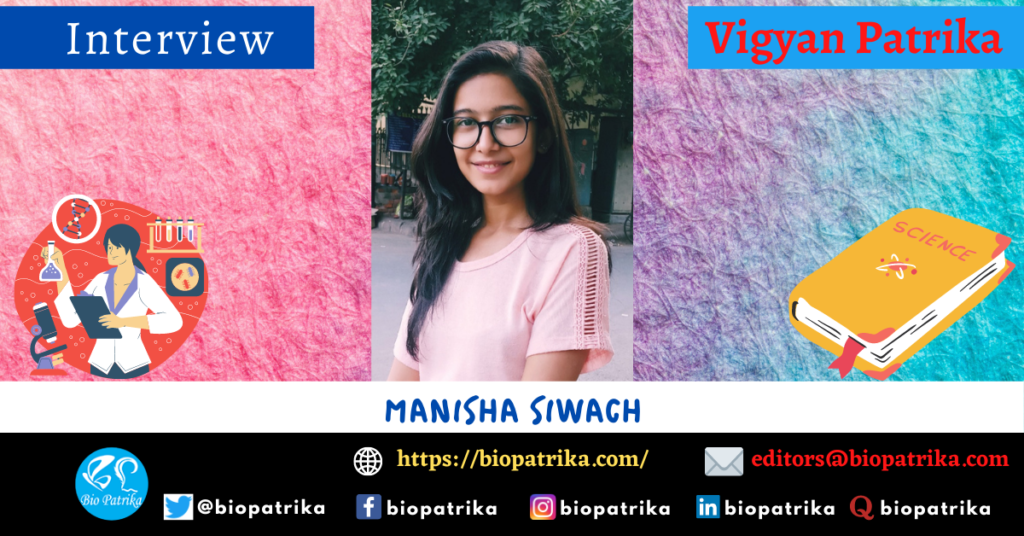Miss Manisha Siwach’s interview with Bio Patrika hosting “Vigyan Patrika”, a series of author interviews. Manisha did her under graduation in Microbiology from Bhaskaracharya College of Applied Sciences, Delhi University. Following that, she completed her Master’s degree in Biotechnology from Hyderabad Central University, India. Currently, she is pursuing her PhD under the supervision of Dr. Sunish Kumar Radhakrishnan in the Department of Biology at the Indian Institute of Science Education and Research, Pune, India. She loves biochemistry and genetics and further aspires to continue research on cell cycle control and differentiation in bacterial cells. Here, Manisha talks about her work titled “An organelle-tethering mechanism couples flagellation to cell division in bacteria”, published as the first author in Developmental Cell, 2021.
How would you explain your paper’s key results to the non-scientific community?
Flagellum is the primary organelle used for swimming-based locomotion in bacteria. The flagellum-mediated locomotion helps bacterial cells disperse out in search of new nutrient-rich conditions, such as new host cell surfaces in case of pathogenic bacteria. The components of the flagellum are divided into different classes. The flagellum assembly is hierarchical, where production of each class happens only once the components from the preceding class are produced and assembled properly. The defects in the flagellum assembly hamper the bacterial cell division preventing bacteria from proliferating, specially found in the group of free-living and pathogenic bacteria. Bacteria also ensures that the newly formed daughter cells are flagellated and are capable of swimming out. However, the mechanism that couples flagellation to cell division remained unknown. Using the unipolar flagellated model organism Caulobacter crescentus, our work unravels the underlying mechanism that links cell division to proper flagellar assembly. We show that, in a group of gram-negative bacteria, the newly discovered regulator, named MadA, senses the assembly of the inner membrane flagellar components to license cell division.
As the MadA-mediated signaling mechanism targets two crucial events during bacterial development, components of this mechanism can be exploited as therapeutic targets in efforts to design new drugs to combat pathogenic bacteria.
What are the possible consequences of these findings for your research area?
Our study underlines the role of the regulator MadA in linking flagellar assembly to cell division. This coupling mechanism likely ensures the inheritance of flagellum by the daughter cells after cell division. Since MadA is a conserved protein among alpha-proteobacteria, we predict that such flagellar-linked cell division mechanisms are prevalent in other bacterial cell types as well. As the MadA-mediated signaling mechanism targets two crucial events during bacterial development, components of this mechanism can be exploited as therapeutic targets in efforts to design new drugs to combat pathogenic bacteria.
What was the exciting moment (eureka moment) during your research?
Though all the findings contributed by the other authors of the manuscript, starting from the discovery of MadA and its suppressors from the genetic screens to delineate the signaling cascade were exciting, the results specially from the co-purification experiments, were the “eureka” moment for me. These results notably strengthened the key finding of this study. The co-purification experiments, together with the yeast-two-hybrid assays helped us establish the in vivo interaction of MadA with the inner-membrane components of the flagella, which was crucial in understanding the mechanism in detail.
What do you hope to do next?
Many interesting questions are still left to be answered. For example, how does MadA sense the assembly of early flagellar components? What type of structural change does MadA induce on the flagellar secretion machinery? Interestingly, certain conditional suppressors of MadA do not assemble a flagellum. However all the components are made – raises the question as to whether MadA also has a role in regulating the secretion of the late flagellar components.
Where do you seek scientific inspiration?
The zest of discovering something novel any day drives my passion for research. I am truly inspired by the work of my mentor Dr. Sunish Radhakrishnan. I admire his scientific inputs, ideas and amazing skills in implementing them. He is one of the most supportive, modest and positive people, I have got a chance to work with. The feeling of observing culture plates, bacterial morphologies, and various other experimental findings procures my interest in research.
How do you intend to help Indian science improve?
I have a tremendous amount of respect for all the Indian scientists for their contributions to various fields with such limited availability of resources. I also would like to contribute to this scientific community. I truly believe that motivating young minds can be very beneficial for science in our country. Therefore, I would love to organize hands-on-training for the students at school and under-graduation degree levels in the future. I believe that experiencing the thrill of mysterious experiments would generate curiosity in their minds.
Reference
Siwach M, Kumar L, Palani S, Muraleedharan S, Panis G, Fumeaux C, Mony BM, Sanyal S, Viollier PH, Radhakrishnan SK. An organelle-tethering mechanism couples flagellation to cell division in bacteria. Dev Cell. 2021 Mar 8;56(5):657-670.e4. doi: 10.1016/j.devcel.2021.01.013.
Edited by: Neha Varshney

